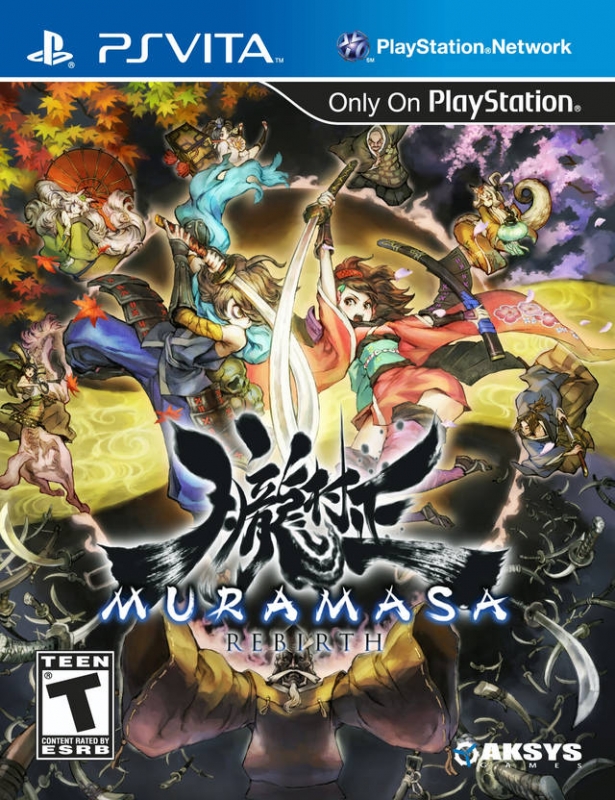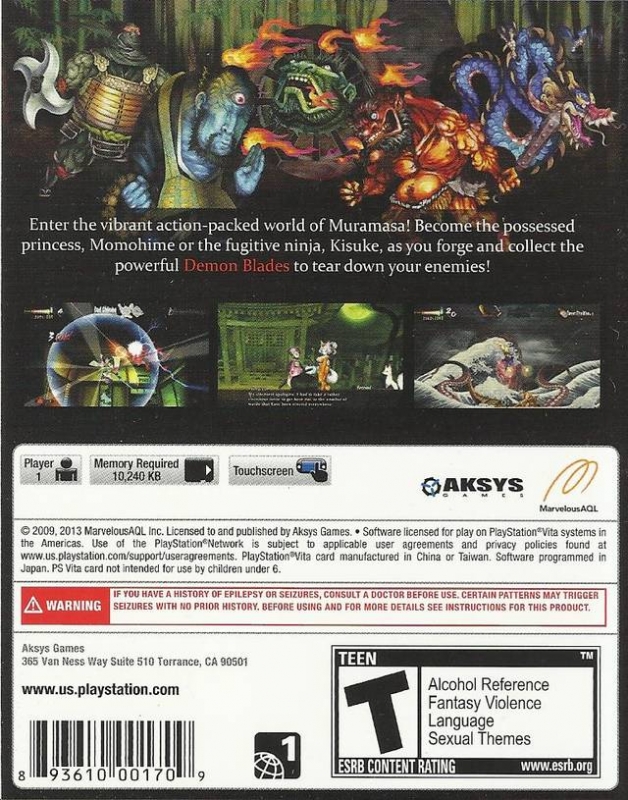Existing User Log In
New User Registration
Register for a free account to gain full access to the VGChartz Network and join our thriving community.





America - Front


America - Back

Muramasa Rebirth is a port of the original 2008 Nintendo Wii game for the PlayStation Vita. Back then the game won accolades for its satisfying combat, intersecting dual narratives, and most of all for its fantastic hand drawn art direction. The big feature touted by developer Vanillaware and publisher Aksys Games is that this release presents that same beautiful game in High Definition for the first time. The game is undoubtedly gorgeous but for my money the setting and gameplay are just as worthy of praise.
Gamers have the choice of controlling either the possessed princess Momohime or the renegade ninja Kisuke. The dual narratives are interesting to follow and you won’t just be playing through the same story twice with the different characters. I played through Momohime’s quest first and of the two found it to be the more enjoyable. Each plot has its own unique set-up and supporting characters and though you traverse the same locales from time to time, you will also travel to new areas as well. The stories intersect in interesting and unexpected ways, together encapsulating a great deal of Japanese mythology and spirituality. Each story features multiple different endings depending on what kind of swords you use, which encourages multiple playthroughs and experimentation.
The controls are easy to master. X to jump, Square to slash when pressed individually and to block when held, Triangle to toggle through your swords, and Circle to activate the sword’s special ability. The right analog stick works for well for movement and the D-pad is used to cycle through and use items.
The game involves a lot of jumping around from place to place but you are never in any danger of missing a jump or incurring damage so I hesitate to call it a platformer. Combat also requires a lot of jumping and double jumping as well. Combos can be continued in the air by moving the analog stick towards airborne enemies while slashing. You can also glide in mid air after jumping. These fluid movements add to the graceful look of the game in motion.
There are two different styles of play pertaining to the game's combat. Chaos is the more challenging of the two, requiring you to dodge and block attacks more frequently. Legend is ideal for more casual players that just want to hack and slash away without worrying about precise timing. No matter which style you choose the combat is pretty satisfying. The battle system would become repetitive very quickly if it were not for the 108 different swords found in the game. Each sword has its own attributes, strike form, and special ability to help take down enemies. When you swap one sword out for another you unleash a powerful slash that attacks all enemies on-screen.
Other gameplay elements complement the combat nicely. You can forge new swords at your own discretion. You can buy meals at restaurants or cook your own food to restore your HP. You can track down monkeys throughout the wilderness that will lead you to secret hot springs that restore your health and vitality. There are also Cave of Evil challenges where you face off against hoards of challenging enemies. To clear all of the Caves of Evil will extend your play time considerably but by then the combat may seem too repetitive. The game’s map is huge and filled with secret areas and special barriers to take down to encourage exploration.
The soundtrack is beautifully arranged, with a score taking cues from traditional oriental melodies, remixing them into a fast paced and dramatic accompaniment. The dialogue features the original Japanese voice acting with English subtitles, which further adds to the Japanese atmosphere, and the sword slashes and other sound effects frequently heard during combat help immerse you in the game's theme of historical warfare.
Graphically, Muramasa Rebirth holds up quite nicely. The 2D images are not quite as sharp as I expected they would be on the Vita's screen but they are nice to look at nonetheless. The art direction, overall, is superb. Sadly, the game slows down from time to time when there are too many enemies crowding the screen. Playing through the game you also start to notice that a lot of assets and backgrounds are recycled throughout the adventure. Character designs, on the other hand, are extraordinary. You will be facing off against a trio of giant centipedes, colossal undead samurai, and all manner of dastardly deities, while more standard enemies include ninjas, monsters, and samurai.
Disappointingly, the game lacks any specific Vita functionality. The touchscreen, rear touchpad, gyroscopic motion controls, and second analog stick are all ignored during gameplay. The menus do not even let you navigate via touchscreen. This game could just have easily been a PSP release. As far as additional content goes, there are extra characters and scenarios to play with that are not found in the original release.
My first playthrough of both adventures clocked in at around 12 hours, split roughly even between them. 12 hours is poor for an RPG but palatable for a hack and slash title, so the value assessment depends largely on how you personally classify Murumasa Rebirth. Both campaigns can be completed in considerably less time if you rush through the game — there is even a trophy for completing the adventures in less than 3 hours. Muramasa Rebirth costs $40 at retail and $36 for download from the PlayStation Store, which is a bit high for a 5 year old game that offers little in the way of new content or functionality.
Overall, Muramasa Rebirth is still a great game but not necessarily a great re-release. Not much has been added to this experience to make it worth checking out for anyone that has played the original. But if you have not experienced this game before then Muramasa Rebirth is one of the most satisfying Vita releases in a long time.
This review is based a digital version of Muramasa Rebirth downloaded from the PlayStation Store.










|
|
|
|
|
PlayMatt
posted 05/02/2014, 06:57
@Fededx You should try the Vita version if you really loved this game! It looks much prettier on the Vita screen and has an infinitely better localization, the dialogues have a real soul now! On the wii they were empty and were not that interesting! Vita's version has "real" texts and some really funny sections without being unfaithful to the original game! Also it will get some really cool DLCs! If you're a Vanillaware fan I recommend you to really get a Vita as their newer game, Dragon's Crown is in it as well! And I have a feeling they will keep on supporting Vita! Message | Report |
|
|
Kresnik
posted 19/01/2014, 10:24
It sold more on Vita in one year in Japan (+ digital) than it did on Wii in its lifetime with a budget re-release. The developers are Japanese and only really care about that market, so yeah, it got DLC on Vita and not Wii. (Did Wii actually have a system for implementing DLC?) Message | Report |
|
|
|
|
|
|